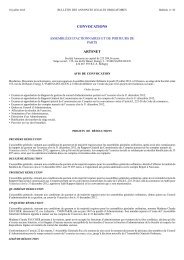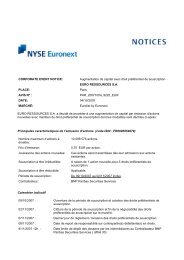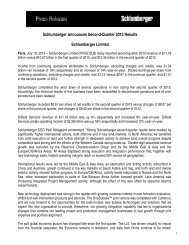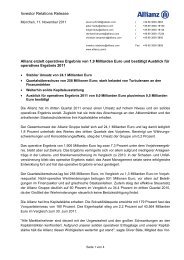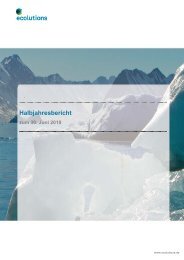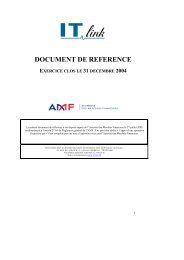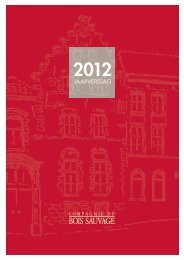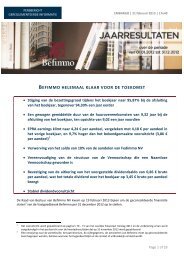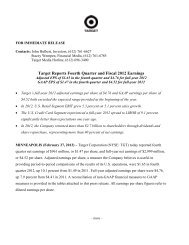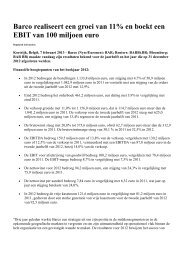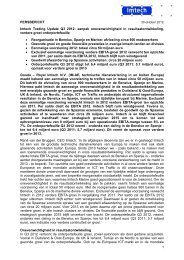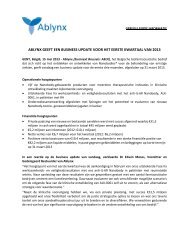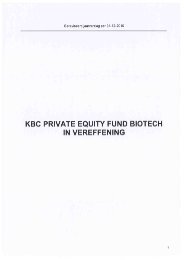FORM 10-Q
FORM 10-Q
FORM 10-Q
You also want an ePaper? Increase the reach of your titles
YUMPU automatically turns print PDFs into web optimized ePapers that Google loves.
not impact the Company's unit case volume on a consolidated basis or at the geographic operating segment level. We recognize unit case volume for all sales of<br />
Company beverage products regardless of our ownership interest in the bottling partner, if any. However, the unit case volume reported by our Bottling<br />
Investments operating segment is generally impacted by structural changes because it only includes the unit case volume of our consolidated bottling<br />
operations.<br />
The Company acquired bottling operations in Vietnam, Cambodia and Guatemala in 2012 and sold a majority interest in our previously consolidated<br />
Philippine bottling operations in 2013. Accordingly, the impact to net operating revenues related to these acquisition and disposal activities was included as a<br />
structural change in our analysis of changes to net operating revenues. Refer to the heading "Net Operating Revenues" below.<br />
In January 2012, the Company announced that Beverage Partners Worldwide ("BPW"), our joint venture with Nestlé S.A. ("Nestlé") in the ready-to-drink tea<br />
category, would focus its geographic scope primarily on Europe and Canada. The joint venture was phased out in all other territories in a transition completed<br />
by the end of 2012, and the Company's U.S. license agreement with Nestlé also terminated at the end of 2012. The impact to net operating revenues for North<br />
America related to the termination of our license agreement has been included as a structural change in our analysis of changes to net operating revenues. In<br />
addition, we have eliminated the BPW and Nestlé licensed unit case volume and associated concentrate sales for the three months ended March 30, 2012, in<br />
those countries impacted by these changes during 2012. Refer to the headings "Beverage Volume" and "Net Operating Revenues" below.<br />
The Company sells concentrates and syrups to both consolidated and unconsolidated bottling partners. The ownership structure of our bottling partners<br />
impacts the timing of recognizing concentrate revenue and concentrate sales volume. When we sell concentrates or syrups to our consolidated bottling partners,<br />
we are not able to recognize the concentrate revenue or concentrate sales volume until the bottling partner has sold finished products manufactured from the<br />
concentrates or syrups to a customer. When we sell concentrates or syrups to our unconsolidated bottling partners, we recognize the concentrate revenue and<br />
concentrate sales volume when the concentrates or syrups are sold to the bottling partner. The subsequent sale by our unconsolidated bottling partners of the<br />
finished products manufactured from the concentrates or syrups to a customer does not impact the timing of recognizing the concentrate revenue or concentrate<br />
sales volume. We eliminate from our financial results all significant intercompany transactions, including the intercompany portion of transactions with<br />
certain of our unconsolidated bottling partners that are accounted for under the equity method of accounting.<br />
"Acquired brands" refers to brands acquired during the past 12 months. Typically, the Company has not reported unit case volume or recognized concentrate<br />
sales volume related to acquired brands in periods prior to the closing of a transaction. Therefore, the unit case volume and concentrate sales volume from the<br />
sale of these brands is incremental to prior year volume. We do not generally consider acquired brands to be structural changes.<br />
During the second quarter of 2012, the Company invested in the existing beverage business of Aujan Industries ("Aujan"), one of the largest independent<br />
beverage companies in the Middle East. Under our definitive agreement with Aujan, the Company now owns 50 percent of the Aujan entity that holds the<br />
rights to Aujan-owned brands in certain territories and 49 percent of Aujan's bottling and distribution operations in certain territories. Accordingly, the volume<br />
associated with the Aujan transaction during the first quarter of 2013 is considered to be from acquired brands. Refer to the heading "Beverage Volume" below.<br />
"License agreements" refers to brands not owned by the Company but for which we hold certain rights, generally including, but not limited to, distribution<br />
rights, and we derive an economic benefit from the ultimate sale of these brands. Typically, the Company has not reported unit case volume or recognized<br />
concentrate sales volume related to these brands in periods prior to the beginning of the term of a license agreement. Therefore, the unit case volume and<br />
concentrate sales volume from the sale of these brands is incremental to prior year volume. We do not generally consider new license agreements to be structural<br />
changes.<br />
Beverage Volume<br />
We measure the volume of Company beverage products sold in two ways: (1) unit cases of finished products and (2) concentrate sales. As used in this report,<br />
"unit case" means a unit of measurement equal to 192 U.S. fluid ounces of finished beverage (24 eight-ounce servings); and "unit case volume" means the<br />
number of unit cases (or unit case equivalents) of Company beverage products directly or indirectly sold by the Company and its bottling partners to<br />
customers. Unit case volume primarily consists of beverage products bearing Company trademarks. Also included in unit case volume are certain products<br />
licensed to, or distributed by, our Company, and brands owned by Coca-Cola system bottlers for which our Company provides marketing support and from<br />
the sale of which we derive economic benefit. In addition, unit case volume includes sales by joint ventures in which the Company has an equity interest. We<br />
believe unit case volume is one of the measures of the underlying strength of the Coca-Cola system because it measures trends at the consumer level. The unit<br />
case volume numbers used in this report are derived based on estimates received by the Company from its bottling partners and distributors. Concentrate sales<br />
volume represents the amount of concentrates and syrups (in all cases expressed in equivalent unit cases) sold by, or used in finished beverages sold by, the<br />
Company to its bottling partners or other customers. Unit case volume and concentrate sales volume growth rates are not necessarily equal during any given<br />
period. Factors such as seasonality, bottlers'<br />
28



